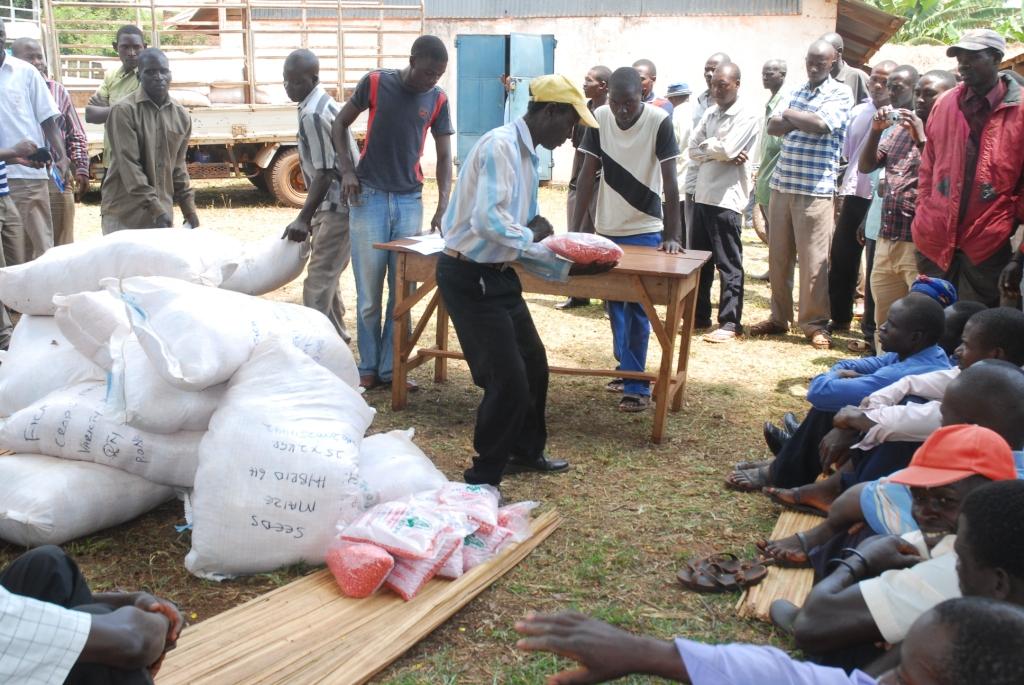Joan Orombi, a resident of Jupayiki village in Goli-Erussi sub-county, Nebbi district, opened a two-acre piece of land to plant maize in the ongoing season of March-July.
Orombi, a mother of four, did not plant on time over delay to get improved seeds as she lacked the money.
She went for saved seeds, buying a kilogram at sh1,800 from produce stores, a price that had increased from sh1,000 two months ago.
Orombi who needed 60 kilograms per acre spent sh216,000 despite warnings by agronomists that the saved seed varieties are not suitable because they don’t yield much and are prone to pests and diseases.
“Some of the crops or varieties that can be affected by pests and diseases is being used by farmers and will become a challenge and she is at the verge of losing out on production,” Dr. Charles Kajura, the Hoima district Production and Marketing Officer, told The Albertine Journal.
Kajura says this comes at a time when the seed saving culture is also fading because of the modern technologies which are coming up.
He says if a farmer gets hybrid maize seed, it is just produced once, and planted once, and a farmer is not supposed to regenerate it into another season because it will not perform.
“It is not like when we used to have our local maize and then you would take it through several seasons’ in terms of the seed you are using.”
As a result, over the past years, farmers’adoption of improved and manufactured agricultural inputs which must be got from seed companies has increased exponentially.
What baffles Kajura is a trend where the costs of inputs are getting high and this is becoming a challenge to the farmers and might affect production in this season and the coming one.
Fertilisers such as CAN, DAR and NPK cost rose from sh150,000 for a bag of 50 kilograms to sh270,000, almost doubling since July 2022.
Kajura attributes it to the ongoing Ukrainian war which has a global effect where the world used to get cheap supplies of the various raw-materials for fertiliser production and yet locally Uganda is unable to scale up production of fertiliser.
“Importation of fertilizer has been affected and therefore it is scarce and when there is scarcity in the market whatever little is available becomes expensive.”
For seed varieties, a kilogram of DK or Avani which are improved maize seeds has increased from sh7,000 to sh12,000.
For maize agronomists recommend 10-15 kilograms in an acre and beans where a kilogram has increased to sh5,000 from sh2,000, they recommend 25-30 kilograms in an acre, rice 30 kilograms and fertiliser 50 kilograms are recommended in an acre.
“It is really a big challenge and yet today you cannot grow and expect good yields without application of fertilisers on crops and planting improved seeds,” Kajura added.
Edward Ssentongo, a farmer in Ntwetwe sub-county, Kiboga district in Central Uganda, said the cost of agro-chemicals including herbicides and pesticides are equally high.
He says a two-littre bottle of ForceUp which they use to spray and kill weeds was by May 5, 2023 selling at sh30,000 up from sh20,000.
Jackson Aheebwa, an economist said the cost of financing by banks is also high for most of the commodities, adding that similarly when it comes to production, someone producing a seedling when he calculates the cost and puts some profits, the cost goes high.
“It is an issue that is supposed to be addressed by the government and by price stablisation and steps such as subsidising through tax cuts are taken to save the situation.”
Abdul Karamagi, a farmer in Busaana sub-county in Kayunga district, told The Albertine Journal by phone that some people in his area have opened land but they are failing to access inputs and planting materials.
He said others have abandoned agriculture and found attraction in non-farming work.
“Of course if we cannot provide the seed for farmers to plant and produce early we end up not producing enough and we get into a problem of food insecurity and this affects the economy,” Kajura observed.
“This affects prices and inflation and the poor people will suffer most. There you can have a terrible scenario that can cause chaos or an uprising because of famine. The government may fail to get relief supplies to support food insecure people.”
Aheebwa says this will also translate into the economic slowdown. “Most of the non-traditional cash crops (food) produced is usually exported. So, if there is low production the country will lose out on earnings.”
He says the government will be forced to import to sustain people and in the process lose money which could be put to other development needs.
Agriculture in Uganda employs 80% of the population, where 69% rely on subsistence farming as their main source of livelihood.
It contributes 40% of the country’s exports and has been central to economic growth and poverty eradication.
The Vision 2040 aimed at transforming Uganda from a peasantry and low-income country to a competitive middle-income country named agriculture as one of the enablers.
However, Uganda is still characterized by food shortage leading to hunger and starvation coupled with the growing population which has averaged 3.12% per annum while agriculture sector growth has been at 0.21%.
Over the last 30 years Uganda has realised miserable agricultural productivity growth out-put per unit factor.
Kajura says farmers need subsidised and better inputs and seeds so that one acre of land produces more crops.
“Ideally, one seed should bear more kilograms of the crop and a person should open more land under cultivation per hour and must stop using the hand hoe which lengthens the time spent digging in the garden,” he said.
In developed countries such as Denmark that apply modern technology like use of tractors, combined harvesters and irrigation, one acre of land produces 13,000 kilograms of maize.
In Uganda one acre planted using saved seeds produces 900 kilograms and if one planted improved seeds (which are fast maturing and highly yielding) gets 3,000 kilograms.
Kajura says increased fertiliser usage is needed to boost the country’s agricultural production and productivity.
Without revealing statistics, he avers that the current fertiliser usage in Uganda remains low and contrary to what is stated in the National Fertiliser Policy, the National Agricultural Policy, the Agricultural Sector Strategic Plan, and the Abuja Fertiliser Summit Declaration 2006.
The Abuja fertiliser summit declaration recommended that African Countries apply 50 kilograms of nutrients per hectare in order to achieve the comprehensive target of six percent annual growth in the agricultural sector.
Kajura said the government needs to address obstacles affecting the development of the fertiliser sub-sector and access to improved seed varieties.
In the past the government through National Agricultural Advisory Services (NAADS) and Operation Wealth Creation (OWC) used to donate seeds to farmers and through their members of parliament (MPs).
The issue of failure by farmers to access inputs, especially seeds reached parliament during a plenary seating on March 30, 2023 when lawmakers tasked the agricultural ministry to explain why they are not giving out seeds to farmers.
Subsequently, the government announced that it had availed sh4b to procure seeds for farmers before the end of the current rainy season in early April.
The seeds were to be distributed to the farmers through MPs in their respective constituencies.
MatiaKasaija, the finance minister, who attributed it to a delay in resource allocation, told lawmakers that the funds of the seedlings had been diverted to the Parish Development Model programme (PDM).
Speaker of Parliament, Anita Among, directed the government to avail money for the seedlings, saying PDM provides to only 39% of the farmers.
“It is a rainy season; you made Ugandans to get used to getting seeds every planting season. Can you tell us what plans you have for planting materials together with hand hoes?” she asked.
However, by May 5, the said seedlings had not yet been given to the MPs for distribution to farmers.

Farmers receive a donation of maize seeds at Bulindi extension centre in Kyabigambire Sub-county, Hoima district in 2011. Credit: Robert Atuhairwe/The Albertine Journal.
Stephen Aseera Itaza, the Buhaguzi East MP in Kikuube district told The Albertine Journal that they have abandoned the distribution since they had already delayed.
“We are getting ready for the coming planting season,” he added. Aheebwa said creating a culture of donating to farmers is not good as it makes them lazy but subsidies and the credit access for farmers was a better option.
He says some of the challenges are coming because farmers are working as individuals, adding if they worked in groups it would be very easy to get around some of these challenges.
“If they worked in groups, they could bulk their inputs and reduce the cost of accessibility. Like we have cooperatives, it would be easier to avail some of the inputs than to individual farmers.”
Itaza says there is a need to amend the seed policy because it has its concerns.
The seed policy is about providing quality seeds and it is mainly driven by the private sector especially what is demanded on the market and government comes in to regulate a few areas.
“The government does not impose on what to produce.They are driven by global markets and demands for these crops and that is what they are producing.For example, if one looked for millet seeds it would be hard to get from these seed companies,” he added.
Kajura on the other hand attributes it to privatisation which has absolved the government from its responsibility.
“Otherwise if we were producing the seeds alone and providing it to the farmers we would not be meeting these challenges.We would make sure that there is enough supply of inputs to the farmers,” Hoima production and marketing officer, added.

